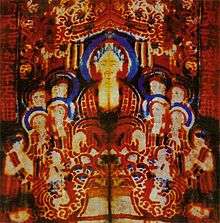Woodcut


Woodcut is a relief printing technique in printmaking. An artist carves an image into the surface of a block of wood—typically with gouges—leaving the printing parts level with the surface while removing the non-printing parts. Areas that the artist cuts away carry no ink, while characters or images at surface level carry the ink to produce the print. The block is cut along the grain of the wood (unlike wood engraving where the block is cut in the end-grain). The surface is covered with ink by rolling over the surface with an ink-covered roller (brayer), leaving ink upon the flat surface but not in the non-printing areas.
Multiple colors can be printed by keying the paper to a frame around the woodblocks (using a different block for each color). The art of carving the woodcut can be called "xylography", but this is rarely used in English for images alone, although that and "xylographic" are used in connection with blockbooks, which are small books containing text and images in the same block. Single-leaf woodcut is a term for a woodcut presented as a single image or print, as opposed to a book illustration.
Division of labour
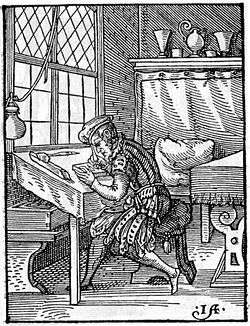
In both Europe and the Far East, traditionally the artist only designed the woodcut, and the block-carving was left to specialist craftsmen, called block-cutters, or Formschneider in Germany, some of whom became well known in their own right. Among these the best known are the 16th century Hieronymus Andreae (who also used "Formschneider" as his surname), Hans Lützelburger and Jost de Negker, all of whom ran workshops and also operated as printers and publishers. The formschneider in turn handed the block on to specialist printers. There were further specialists who made the blank blocks.
This is why woodcuts are sometimes described by museums or books as "designed by" rather than "by" an artist; but most authorities do not use this distinction. The division of labour had the advantage that a trained artist could adapt to the medium relatively easily, without needing to learn the use of woodworking tools.
There were various methods of transferring the artist's drawn design onto the block for the cutter to follow. Either the drawing would be made directly onto the block (often whitened first), or a drawing on paper was glued to the block. Either way, the artist's drawing was destroyed during the cutting process. Other methods were used, including tracing.
In both Europe and the Far East, such as Japan and China, in the early twentieth century some artists began to do the whole process themselves. In Japan, this movement was called Sōsaku hanga, as opposed to the Shin hanga movement, which retained the traditional methods. In the West, many artists used the easier technique of linocut instead.
Methods of printing
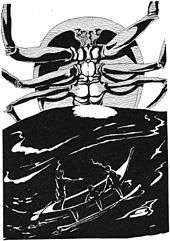
Compared to intaglio techniques like etching and engraving, only low pressure is required to print. As a relief method, it is only necessary to ink the block and bring it into firm and even contact with the paper or cloth to achieve an acceptable print. In Europe a variety of woods including boxwood and several nut and fruit woods like pear or cherry were commonly used;[1] in Japan, the wood of the cherry species Prunus serrulata was preferred.
There are three methods of printing to consider:
- Stamping: Used for many fabrics and most early European woodcuts (1400–40). These were printed by putting the paper/fabric on a table or other flat surface with the block on top, and pressing or hammering the back of the block
- Rubbing: Apparently the most common method for Far Eastern printing on paper at all times. Used for European woodcuts and block-books later in the fifteenth century, and very widely for cloth. Also used for many Western woodcuts from about 1910 to the present. The block goes face up on a table, with the paper or fabric on top. The back is rubbed with a "hard pad, a flat piece of wood, a burnisher, or a leather frotton".[2] A traditional Japanese tool used for this is called a baren. Later in Japan, complex wooden mechanisms were used to help hold the woodblock perfectly still and to apply proper pressure in the printing process. This was especially helpful once multiple colors were introduced and had to be applied with precision atop previous ink layers.
- Printing in a press: presses only seem to have been used in Asia in relatively recent times. Printing-presses were used from about 1480 for European prints and block-books, and before that for woodcut book illustrations. Simple weighted presses may have been used in Europe before the print-press, but firm evidence is lacking. A deceased Abbess of Mechelen in 1465 had "unum instrumentum ad imprintendum scripturas et ymagines ... cum 14 aliis lapideis printis"—"an instrument for printing texts and pictures ... with 14 stones for printing." This is probably too early to be a Gutenberg-type printing press in that location.[2]
History
Main articles Old master print for Europe, Woodblock printing in Japan for Japan, and Lubok for Russia
Woodcut or woodblock printing is a technique for printing text, images or patterns that was used widely throughout East Asia. It originated in China in antiquity as a method of printing on textiles and later on paper.The earliest woodblock printed fragments to survive are from China and are of silk printed with flowers in three colours from the Han Dynasty (before AD 220).[3] "In the 13th century the Chinese technique of blockprinting was transmitted to Europe."[4] Paper arrived in Europe, also from China via Islamic Spain, slightly later, and was being manufactured in Italy by the end of the thirteenth century, and in Burgundy and Germany by the end of the fourteenth.
In Europe, woodcut is the oldest technique used for old master prints, developing about 1400, by using, on paper, existing techniques for printing. One of the more ancient woodcuts on paper that can be seen today is The Fire Madonna (Madonna del Fuoco, in the Italian language), in the Cathedral of Forlì, in Italy.
The explosion of sales of cheap woodcuts in the middle of the century led to a fall in standards, and many popular prints were very crude. The development of hatching followed on rather later than engraving. Michael Wolgemut was significant in making German woodcuts more sophisticated from about 1475, and Erhard Reuwich was the first to use cross-hatching (far harder to do than engraving or etching). Both of these produced mainly book-illustrations, as did various Italian artists who were also raising standards there at the same period. At the end of the century Albrecht Dürer brought the Western woodcut to a level that, arguably, has never been surpassed, and greatly increased the status of the single-leaf woodcut (i.e. an image sold separately).
As woodcut can be easily printed together with movable type, because both are relief-printed, it was the main medium for book illustrations until the late-sixteenth century. The first woodcut book illustration dates to about 1461, only a few years after the beginning of printing with movable type, printed by Albrecht Pfister in Bamberg. Woodcut was used less often for individual ("single-leaf") fine-art prints from about 1550 until the late nineteenth century, when interest revived. It remained important for popular prints until the nineteenth century in most of Europe, and later in some places.
The art reached a high level of technical and artistic development in East Asia and Iran. In Japan woodblock printing is called "moku hanga", and was introduced in the seventeenth century for both books and art. The popular "floating world" genre of ukiyo-e originated in the second half of the seventeenth century, with prints in monochrome or two colours. Sometimes these were hand-coloured after printing. Later prints with many colours were developed. Japanese woodcut became a major artistic form, although at the time it was accorded a much lower status than painting. It continued to develop through to the twentieth century.
White-line woodcut
This technique just carves the image in mostly thin lines, not unlike a rather crude engraving. The block is printed in the normal way, so that most of the print is black with the image created by white lines. This process was invented by the sixteenth-century Swiss artist Urs Graf, but became most popular in the nineteenth and twentieth century, often in a modified form where images used large areas of white-line contrasted with areas in the normal black-line style. This was pioneered by Félix Vallotton.
Japonism
In the 1860s, just as the Japanese themselves were becoming aware of Western art in general, Japanese prints began to reach Europe in considerable numbers, and became very fashionable, especially in France. They had a great influence on many artists, notably Édouard Manet, Pierre Bonnard, Henri de Toulouse-Lautrec, Edgar Degas, Paul Gauguin, Vincent van Gogh, Félix Vallotton and Mary Cassatt. In 1872 Jules Claretie dubbed the trend "Le Japonisme".[5]
Though the Japanese influence was reflected in many artistic media, including painting, it did lead to a revival of the woodcut in Europe, which had been in danger of extinction as a serious art medium. Most of the artists above, except for Félix Vallotton and Paul Gauguin, in fact used lithography, especially for coloured prints. See below for Japanese influence in illustrations for children's books.
Artists, notably Edvard Munch and Franz Masereel, continued to use the medium, which in Modernism came to appeal because it was relatively easy to complete the whole process, including printing, in a studio with little special equipment. The German Expressionists used woodcut a good deal.
Colour

Coloured woodcuts first appeared in ancient China. The oldest known are three Buddhist images dating to the 10th century. European woodcut prints with coloured blocks were invented in Germany in 1508 and are known as chiaroscuro woodcuts (see below). However, colour did not become the norm, as it did in Japan, in the ukiyo-e and other forms.
In Europe and Japan, colour woodcuts were normally only used for prints rather than book illustrations. In China, where the individual print did not develop until the nineteenth century, the reverse is true, and early colour woodcuts mostly occur in luxury books about art, especially the more prestigious medium of painting. The first known example is a book on ink-cakes printed in 1606, and colour technique reached its height in books on painting published in the seventeenth century. Notable examples are Hu Zhengyan's Treatise on the Paintings and Writings of the Ten Bamboo Studio of 1633,[6] and the Mustard Seed Garden Painting Manual published in 1679 and 1701.[7]
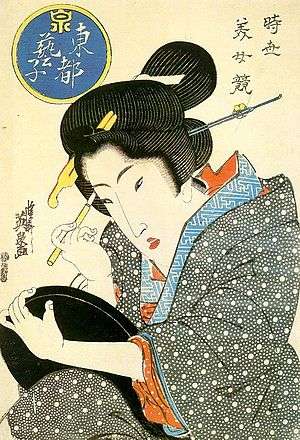
In Japan colour technique, called nishiki-e in its fully developed form, spread more widely, and was used for prints, from the 1760s on. Text was nearly always monochrome, as were images in books, but the growth of the popularity of ukiyo-e brought with it demand for ever increasing numbers of colors and complexity of techniques. By the nineteenth century most artists worked in colour. The stages of this development were:
- Sumizuri-e (墨摺り絵, "ink printed pictures") - monochrome printing using only black ink
- Benizuri-e (紅摺り絵, "crimson printed pictures") - red ink details or highlights added by hand after the printing process;green was sometimes used as well
- Tan-e (丹絵) - orange highlights using a red pigment called tan
- Aizuri-e (藍摺り絵, "indigo printed pictures"), Murasaki-e (紫絵, "purple pictures"), and other styles that used a single color in addition to, or instead of, black ink
- Urushi-e (漆絵) - a method that used glue to thicken the ink, emboldening the image; gold, mica and other substances were often used to enhance the image further. Urushi-e can also refer to paintings using lacquer instead of paint; lacquer was very rarely if ever used on prints.
- Nishiki-e (錦絵, "brocade pictures") - a method that used multiple blocks for separate portions of the image, so a number of colors could achieve incredibly complex and detailed images; a separate block was carved to apply only to the portion of the image designated for a single color. Registration marks called kentō (見当) ensured correspondence between the application of each block.

In the 19th century a number of different methods of colour printing using woodcut (technically Chromoxylography) were developed in Europe. George Baxter patented in 1835 a method using an intaglio line plate (or occasionally a lithograph), printed in black or a dark colour, and then overprinted with up to twenty different colours from woodblocks. Edmund Evans used relief and wood throughout, with up to eleven different colours, and latterly specialized in illustrations for children's books, using fewer blocks but overprinting non-solid areas of colour to achieve blended colours. Artists such as Randolph Caldecott, Walter Crane and Kate Greenaway were influenced by the Japanese prints now available and fashionable in Europe to create a suitable style, with flat areas of colour.

In the 20th century, Ernst Ludwig Kirchner of the Die Brücke group developed a process of producing colored woodcut prints using a single block applying different colors to the block with a brush à la poupée and then printing (halfway between a woodcut and a monotype).[8] A remarkable example of this technique is the 1915 Portrait of Otto Müller woodcut print from the collection of the British Museum.[9]
Gallery of Asian woodcuts
-

Jiaozi (currency), 10th century, Sichuan, China.
-
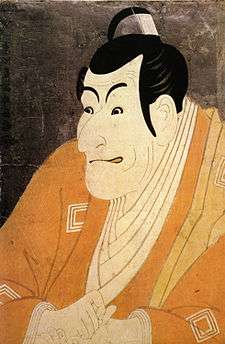
Actor Ichikawa Ebozo as Takemura Sadanoshin, Japanese woodcut by Sharaku, 1794.
-

Dragon, Japanese woodcut by Yoshida Gen'ō, 1892.
-
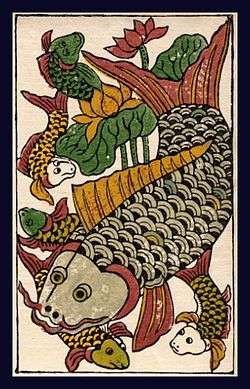
Modern woodcut Carp Painting, Dong Ho Painting, Vietnam.
Chiaroscuro woodcuts

Chiaroscuro woodcuts are old master prints in woodcut using two or more blocks printed in different colours; they do not necessarily feature strong contrasts of light and dark. They were first produced to achieve similar effects to chiaroscuro drawings. After some early experiments in book-printing, the true chiaroscuro woodcut conceived for two blocks was probably first invented by Lucas Cranach the Elder in Germany in 1508 or 1509, though he backdated some of his first prints and added tone blocks to some prints first produced for monochrome printing, swiftly followed by Hans Burgkmair the Elder.[10] Despite Vasari's claim for Italian precedence in Ugo da Carpi, it is clear that his, the first Italian examples, date to around 1516[11][12]
Other printmakers to use the technique include Hans Baldung Grien and Parmigianino. In the German states the technique was in use largely during the first decades of the sixteenth century, but Italians continued to use it throughout the century, and later artists like Goltzius sometimes made use of it. In the German style, one block usually had only lines and is called the "line block", whilst the other block or blocks had flat areas of colour and are called "tone blocks". The Italians usually used only tone blocks, for a very different effect, much closer to the chiaroscuro drawings the term was originally used for, or watercolours. [13]
Europe
- Ars moriendi
- Dürer's Rhinoceros
- Emblem book
- Four horsemen of the Apocalypse
- Hypnerotomachia Poliphili
- Just So Stories
- Lubok prints
Japan
Grisaille woodcut
The Swedish printmaker Torsten Billman (1909-1989) developed during the 1930s and 1940s a woodcut with several gray tones from the ordinary printing ink. The art historian Gunnar Jungmarker (1902-1983) at Nationalmuseum called this technique - grisaille woodcut. A time consuming printing process, exclusively for hand printing, with several grey-wood blocks aside from the black and white key block.[14]
Artists
- Irving Amen
- Mary Azarian
- Aubrey Beardsley
- Hans Baldung
- Leonard Baskin
- Gustave Baumann
- Torsten Billman
- Carroll Thayer Berry
- Erich Buchholz
- Hans Burgkmair
- Domenico Campagnola
- Ugo da Carpi
- Billy Childish
- Salvador Dalí
- Gustave Doré
- Albrecht Dürer
- M. C. Escher
- James Flora
- Antonio Frasconi
- Robert Gibbings
- Vincent van Gogh
- Urs Graf
- Suzuki Harunobu
- Hiroshige
- Jacques Hnizdovsky
- Hokusai
- Tom Huck
- Stephen Huneck
- Alfred Garth Jones
- Hussein el gebaly
- Ernst Ludwig Kirchner
- Käthe Kollwitz
- J.J. Lankes
- Frans Masereel
- Hishikawa Moronobu
- Edvard Munch
- Emil Nolde
- Jacob Pins
- J. G. Posada
- Endi E. Poskovic
- Hannah Tompkins
- Henriette Tirman
- Urs Graf
- Clément Serveau
- Paul Signac
- Eric Slater
- Utamaro
- Marcelo Soares
- Félix Vallotton
- Karel Vik
- Leopold Wächtler
- Susan Dorothea White
- Randi Johansson

See also
- Blockbooks
- Chiaroscuro
- Cordel literature
- Linocut
- Metalcut
- Old master print
- Printmaking
- Rubber stamp
- Scandinavian flat-plane style of woodcarving
- Shin hanga
- Sōsaku hanga
- Wood carving
- Woodblock printing
- Ukiyo-e
Notes
- ↑ Landau & Parshall, 21-22; Uglow, 2006. p. xiii.
- 1 2 Hind, Arthur M. An Introduction to a History of Woodcut. Houghton Mifflin Co. 1935 (in USA), reprinted Dover Publications, 1963. pp. 64–94. ISBN 0-486-20952-0.
- ↑ Shelagh Vainker in Anne Farrer (ed), "Caves of the Thousand Buddhas" , 1990, British Museum publications, ISBN 0-7141-1447-2
- ↑ Hsü, Immanuel C. Y. (1970). The Rise of Modern China. New York: Oxford University Press. p. 830. ISBN 0-19-501240-2.
- ↑ Ives, C F (1974). The Great Wave: The Influence of Japanese Woodcuts on French Prints. The Metropolitan Museum of Art. ISBN 0-87099-098-5.
- ↑ "Shi zhu zhai shu hua pu, or, Ten Bamboo Studio collection of calligraphy and painting". Cambridge Digital Library. Retrieved 11 August 2015.
- ↑ L Sickman & A Soper, "The Art and Architecture of China", Pelican History of Art, 3rd ed 1971, Penguin, LOC 70-125675
- ↑ Carey, Frances; Griffiths, Antony (1984). The Print in Germany, 1880-1933: The Age of Expressionism. London: British Museum Press. ISBN 978-0-7141-1621-1.
- ↑ "Portrait of Otto Müller (1983,0416.3)". British Museum Collection Database. London: British Museum. Retrieved 2010-06-05.
- ↑ so Landau and Parshall, 179-192; but Bartrum, 179 and Renaissance Impressions: Chiaroscuro Woodcuts from the Collections of Georg Baselitz and the Albertina, Vienna, Royal Academy, London, March–June 2014, exhibition guide, both credit Cranach with the innovation in 1507.
- ↑ Landau and Parshall, 150
- ↑ "Ugo da Carpi after Parmigianino: Diogenes (17.50.1) | Heilbrunn Timeline of Art History | The Metropolitan Museum of Art". Metmuseum.org. 2012-02-03. Retrieved 2012-02-18.
- ↑ Landau and Parshall, The Renaissance Print, pp. 179-202; 273-81 & passim; Yale, 1996, ISBN 0-300-06883-2
- ↑ Sjöberg, Leif, Torsten Billman and the Wood Engraver's Art, pp. 165-171. The American Scandinavian Review, Vol. LXI, No. 2, June 1973. New York 1973.
References
- Bartrum, Giulia; German Renaissance Prints, 1490–1550; British Museum Press, 1995, ISBN 0-7141-2604-7
- Lankes, JJ (1932). A Woodcut Manual. H. Holt.
- David Landau & Peter Parshall, The Renaissance Print, Yale, 1996, ISBN 0-300-06883-2
- Uglow, Jenny (2006). Nature's Engraver: A Life of Thomas Bewick. Faber and Faber.
External links
| Wikimedia Commons has media related to Woodcuts. |
- Ukiyo-e from the Metropolitan Museum of Art Timeline of Art History
- Woodcut in Europe from the Metropolitan Museum of Art Timeline of Art History
- Italian Renaissance Woodcut Book Illustration from the Metropolitan Museum of Art Timeline of Art History
- Prints & People: A Social History of Printed Pictures, an exhibition catalog from The Metropolitan Museum of Art (fully available online as PDF), which contains material on woodcuts
- Museum of Modern Art information on printing techniques and examples of prints.
- Woodcut in early printed books (online exhibition from the Library of Congress)
- A collection of woodcuts images can be found at the University of Houston Digital Library
- In Relief Printing Techniques French printmaker Dominique Lecomte explains how to use the technique and shows some of his work.
- Meditations, or the Contemplations of the Most Devout is a 15th-century publication that is considered the first Italian illustrated book, using early woodcut techniques.
|
.jpg)

